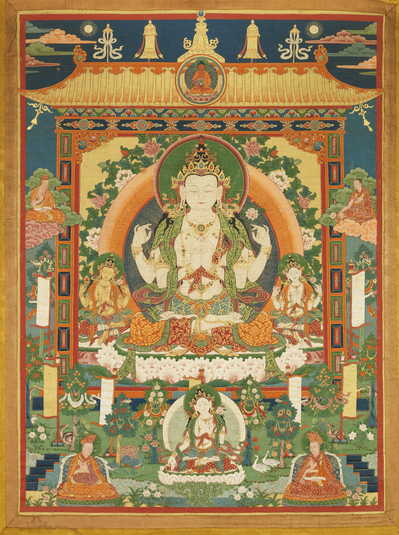
Item: Avalokiteshvara (Bodhisattva & Buddhist Deity) - Chaturbhuja (4 hands)
| Origin Location | Bhutan |
|---|---|
| Date Range | 1800 - 1899 |
| Lineages | Kagyu, Drukpa (Kagyu, Bhutan) and Buddhist |
| Material | Ground Mineral Pigment on Cotton |
| Collection | Private |
Alternate Names: Lokeshvara Avalokita Lokanata Lokanatha Mahakarunika
Classification: Deity
Appearance: Peaceful
Gender: Male
Avalokiteshvara, Chaturbhuja (Tibetan: chen re zi, chag shi pa. English: the All Seeing Lord with Four Hands). There are several forms of Lokeshvara with four hands but the earliest and most famous is the Three Deity Chaturbhuja originating in the Karandavyuha Sutra, also famous for the first use of the six syllable mantra - om mani padme hum.
The central figure is Avalokiteshvara, white in colour, with four hands. At his right is the male attendant Manidharin, yellow in colour, and at the left, the female, Shadakshari, white in colour. Both are similar to the Lord in colour, ornaments and appearance. Sometimes they are referred to as the son and daughter of Lokeshvara. Sometimes Shadakshari is referred to as the consort. The iconography for the two attendant figures is not consistent nor is it necessarily fixed in a single authoritative text. They can appear either white or yellow in colour and have either two arms or four. Often Manidharin appears with two arms and Shadakshari with four.
"As the nature of all buddhas, Avalokiteshvara, in colour like stainless conch and crystal, very resplendent, smiling, peaceful and radiant. With four hands the first are folded at the heart, the lower hold a crystal mala and jewelled lotus, two beautiful feet seated in vajra posture, adorned with many attractive silks and jewels, beautified with dark blue hair in tufts [some] loose. On the crown of the head, the wisdom of all buddhas, is the Lord, source of all refuge gathered as one, in essence the Guru in the aspect of Amitabha, in the manner of the Lord of the Family, seated happily." (Ngorchen Konchog Lhundrub 1497-1557).
The two circles at the top of the composition representing the sun and the moon have mantras written inside. The circle on the viewer's right side has the six-syllable mantra of Lokeshvara originating in the Karandavyuha Sutra: om mani padme hum hrih.
On the lower front brocade mount of the painting is a long inscription describing the benefits of the recitation of the of Karandavyuha mantra of Avalokiteshvara, also known as the six-syllable mantra. The inscription goes on to detail more advanced tantric theory relationships as if presented from the level of Anuttarayoga Tantra.
Front Brocade Inscription: "Displaying a white body with no samsaric defects, two folded hands non-dual dharmakaya, Sambhogakaya wisdom lotus in the left, nirmanakaya method mala in the right, two feet for the benefit of beings on a lotus seat, [to Avalokita] I bow!
To the Great Compassionate one I bow! The six syllables are the syllables of nirmanakaya accomplishing various purposes; recite the syllables of speech for the accomplishment of that.
Om mani padme hum. Applied to the Six bodies, om is the dharmakaya, ma sambhogakaya, ni nirmanakaya, pad svabhavikakaya, me abhisambhodikaya, hum unchanging vajrakaya; to spontaneously obtain the six bodies [rely on] the six syllables.
Om mani padme hum. Applied to the Six Families, om is all families combined as the Great Compassionate One, ma Vairochana, ni Vajrasattva, pad Ratnasambhava, me Amitabha, hum Amoghasiddhi; even the buddhas of the Six Families, reciting the six syllables, obtained the [result].
Om mani padme hum. Applied to the six consorts, om is all families combined in the mother Shadakshari, ma space Samantabhadri, ni earth Buddha Lochana, pad fire Pandara Vasini, me water Mamaki, hum air Samaya Tara; even these five pure elements rely on the recitation of the six syllables.
Om mani padme hum. Applied to the dakinis, om is the mistress of all dakinis Vajrayogini, ma flesh Buddha Dakini, ni mind Vajra Dakini, pad warmth Ratna Dakini, me blood Padma Dakini, hum breath Karma Dakini; to recieve the blessings of the pure inner five elements of the Five Dakini Families rely on the recitation of the six syllables. Ge'o. Sarva mangalam."
The reverse of the painting has a a drawing of a large stupa with various inscriptions written in different scripts inside. The dominant script is Lantza, a Nepalese decorative form of writing. The content of the writing is all mantras along with the Dependent Arising verse in Sanskrit. The majority of the mantras are added for blessing and do not relate to the Lokeshvara subject on the front of the painting.
Inscriptions: Shakyamuni mantra. Dependent Arising verse. Manjushri and Lokeshvara mantras. Vajrapani mantra. Amitayus mantra. Vajrasattva mantra. Manjushri mantra. Chaturbhuja mantra. Padmasambhava mantra. Generic blessing mantras. Akshobhya Buddha mantra. Vaishravana and Jambhala mantras.
The final four-line verse written in Tibetan letters are a dedication of merit: 'By this merit may the sins and obscurations of all beings be purified, all desires and wishes be accomplished; may [all beings] quickly attain the stage of the Great Compassionate One.'
Jeff Watt 8-2017
ཨོཾ་ཨཱ་ཧུཾ། ཨོཾ་བཛྲ་གུརུ་ཌཀིནི་སིདྡྷི་ཧུཾ། ཨོཾ་མུ་ནི་མུ་ནི་མ་ཧཱ་མུ་ནི་ཤཀྱཱ་མུ་ནི་ཡེ་སྭ་ཧཱ། ཨོཾ་ཧེ་དྷརྨ་ཧེ་ཏུ་པྲ་བ་ཝ་ཧེཏུནྟེ་ཤམ་ཏ་ཐ་ག་ཏོ་ཧྱ་བ་དད་ཏེ་ཤམ་ཙ་ཡོ་ནི་རོ་དྷ་ཨེ་ཝམ་ཝ་དྷི་མ་ཧ་ཤྲ་མ་ན་སྭ་ཧཱ།་ཨོཾ་ཧུཾ་ཏྲམ་ཧྲི་ཨཱ། ཨོཾ་ཝ་གི་ཤྭ་རི་མཾ།་ཨོཾ་མ་ཎི་པདྨེ་ཧུཾ་ཧྲི། ཨོཾ་བཛྲ་པ་ནི་ཧུཾ། ཨོཾ་ཨ་མ་ར་ནི་ཛི་ཝེན་ཏེ་ཡི་སྭ་ཧཱ། ཨོཾ་བཛྲ་སཏྭ་ཧུཾ། ཨོཾ་ཀྲིམ་སྭ་ཧཱ། ཨོཾ་མ་ཎི་པདྨེ་ཧུཾ་ཧྲི།་ཨོཾ་མ་ཎི་པདྨེ་ཧུཾ་ཧྲི།་ཨོཾ་མ་ཎི་པདྨེ་ཧུཾ་ཧྲི། ཨོཾ་ཨཱ་ཧུཾ་བཛྲ་གུ་རུ་པདྨ་སིདདྷི་ཧུཾ།་ཨོཾ་སུ་པྲ་ཏིཤྠ་བཛྲ་ཡེ་སྭ་ཧཱ།་ཨོཾ་ཨ་མྲིཏ་ཧུཾ་སྭ་ཧཱ། ཨོཾ་སརྦ་བིདྱ་སྭ་ཧཱ།་ཨོཾ་བཛྲ་ཨ་ཡུ་ཤེ་སྭ་ཧཱ།་ ན་མོ་རཏྣ་ཏྲ་ཡ་ཡ།་ཨོཾ་ཀཾ་ཀ་ནི་ཀཾ་ཀ་ནི་རོ་ཙ་ནི་རོ་ཙ་ནི་ཏྲོ་ཏ་ནི་ཏྲོ་ཏ་ནི་ཏྲ་ས་ནི་ཏྲ་ས་ནི་པྲ་ཏི་ཧ་ན་པྲ་ཏི་ཧ་ན་སརྦ་ཀརྨ་པ་རཾ་པ་ར་ནི་མེ་སརྦ་སཏྭ་ནནྩ་སྭ་ཧཱ། ཨོཾ་བེེཤ་མ་ཎཱ་ཡ་རཏྣ་སིདདྷི་ས་མ་ཡ་ཧུཾ་ཧྲི་ཐཱ། ཨོཾ་གྷ་ཏཾ་ཛམྦྷ་སེ་མ་ས་རཱ་ག་ནི་མ་ཀ་ར་བཛྲ་རཏྣ་ཏི་ང་ཏི་སརྦ་ཛ་ཧུཾ་ཧྲི་ཐཱ། ཨོཾ་ཛམྦྷ་ལ་ཛ་ལེནྡྲཱ་ཡ་རཏྣ་སིདདྷི་ཛ་ཧུཾ་ཧྲི་ཐཱ། ཛཡནྟུ།
དགེ་བ་འདི་ཡིས་མཁའ་མཉམ་སེམས་ཅན་གྱི། སྡིག་དང་སྒྲིབ་པའི་ཚོགས་ཀུན་བྱང་གྱུར་ཏེ། བསམ་པའི་དོན་ཀུན་ཡིད་བཞིན་འགྲུབ་ནས། ཐུགས་རྗེ་ཆེན་པོའི་གོ་འཕང་མྱུར་ཐོབ་ཤོག།
Collection: Bonhams Hong Kong (Painting. October, 2017)
Buddhist Deity: Avalokiteshvara, Chaturbhuja Iconography
Buddhist Deity: Avalokiteshvara Masterworks (Painting)
Buddhist Deity: Lokeshvara, Chaturbhuja (Best Examples, Paintings)
Buddhist Deity: Avalokiteshvara, Chaturbhuja (Three Deity)
Region: Bhutan, Main Page
Buddhist Deity: Avalokiteshvara, Chaturbhuja - Four Hands - Main Page
Buddhist Deity: Avalokiteshvara, Four Hands (Masterworks)
Buddhist Deity: Avalokiteshvara, Four Hands (Painting Masterworks)
Buddhist Deity: Avalokiteshvara Art History
Buddhist Deity: Avalokita, Chaturbhuja, Three Iconographic Topics
Painting Traditions Page



